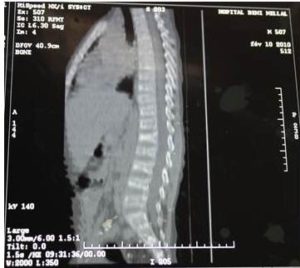Serum calcium level was at 93 mg / L [normal: 85-105], phosphate level was at 55 mg / L [normal: 45-75], LDH level was at 365 IU / L [normal: 160-248] and spinal cerebrospinal fluid (CSF) was normal.
The child was treated with chemotherapy with a dorso lumbar Back Support. He is still in complete remission after two years and half.
Discussion
The osteoarticular manifestations are frequent in the ALL. Osteopenia, lysis of bone, lesions of osteosclerosis and periosteal reactions have been described [4-6]. Vertebral compression is rarely a first manifestation of ALL. In 1987, Samuda et al [7] reported 13 cases, and in 1996 Mandel et al [5] report 3 cases of ALL revealed by vertebral compression.
These vertebral collapses can take many radiological appearances: to be interesting all the vertebral body, the center of the vertebral body or they are cuneiform [5], as in our case.
There are a mean of 7 weeks between the discovery of the vertebral collapse and hematologic diagnosis [4]. This delay is due, firstly, to the fact that many diagnostic can discuss: isthmic spondylolysis, Schumann’s disease, spondylodiscitis and bone malignancies [5, 6], David et al reported a retrospective study of 29 cases of children with malignancies initially addressed in pediatric rheumatology unit (juvenile chronic arthritis, spondyloarthropathies …) [3], on the other hand, the possible absence of biological orientation with an initial normal blood count [6].
The skeletal manifestations with hypercalcemia were secondary to massive infiltration in medullary and periosteal spaces by blasts, responsible of lytic lesions by local destruction or diffuse hyper resorption, secondary to the production of a cytokine involeved in osteoclastic activation or synthesis by blasts of a parathyroid hormone-like [4, 5, 8]. The presence of the initial bone involvement in ALL does not seem to affect the prognosis [1].
The treatment of vertebral collapse is double: orthopedic by wearing a corset for some authors [7] and the specific treatment of ALL [5, 6]. Our patient received an orthopedic treatment with chemotherapy. Complete remission is necessary for the healing of bone lesions [1].
Conclusion
This case shows that delay in diagnosis occurs often when the classic clinical manifestations of acute leukemia are absent. For such patients referred, to the pediatrician, we believe that the diagnosis of malignancy should be considered earlier.The discrete anemia and leukopenia may be the signs of the orientation in the absence of circulating blasts and must perform a bone morrow aspirate.
Consent
Patient’s parents have given their informed consent for the case report to be published.
References
1- Pandya, N. A., Meller, S. T., MacVicar, D. et al. (2001). “Vertebral Compression Fractures in Acute Lymphoblastic Leukaemia and Remodeling after Treatment,” Archives of Disease in Children, 85 (6) 492—493.
Publisher – Google Scholar
2- Santangelo, J. R. & Thomson, J. D. (1999). “Childhood Leukemia Presenting with Back Pain and Vertebral Compression Fractures,” The American Journal of Orthopedics, 28(4) 257-260.
Publisher – Google Scholar
3- Cabral, D. A. & Tucker, L. B. (1999). “Malignancies in Children Who Initially Present with Rheumatic Complaints,”Journal of Pediatrics, 134 (1) 53—57.
Publisher – Google Scholar
4- Roux, S. & Mariette, X. (2005). “Bone and Joints in Haematological Malignancies (Myeloma Excluded),” EMC-Rhumatologie Orthopédie, 2 (2) 109—124
Publisher – Google Scholar
.
5- Mandel, R., Vic, P., Nelker, B. et al. (1996). “Tassements Vertébraux Révélateurs de Leucémie Aigue Lymphoblastique,” Archives de Pediatrie, 3 (5) 466—469.
Publisher – Google Scholar
6- Hbibi, M., Atmani, S., Abourazzak, S. et al. (2011). “Tassement Vertébral Révélant une Leucémie Aigue Chez un Enfant,” Archives de Pédiatrie, 18 (5) 597-599.
Publisher – Google Scholar
7- Samuda, G. M., Cheng, M. Y. & Yeung, C. Y. (1987). “Back Pain and Vertebral Compression: an Uncommon Presentation of Childhood Acute Lymphoblastic Leukemia,” Journal of Pediatric Orthoedics, 7 (2) 175-178.
Publisher – Google Scholar
8- Davies, J. H., Evans, B. A. J., Jenney, M. E. M. & Gregory, J. W. (2005). ”Skeletal Morbidity in Childhood Acute Lymphoblastic Leukaemia,” Clinical Endocrinology, 63 (1) 1-9.
Publisher – Google Scholar





